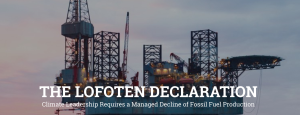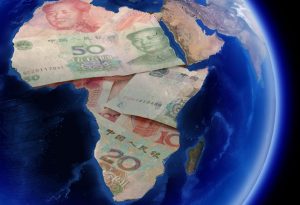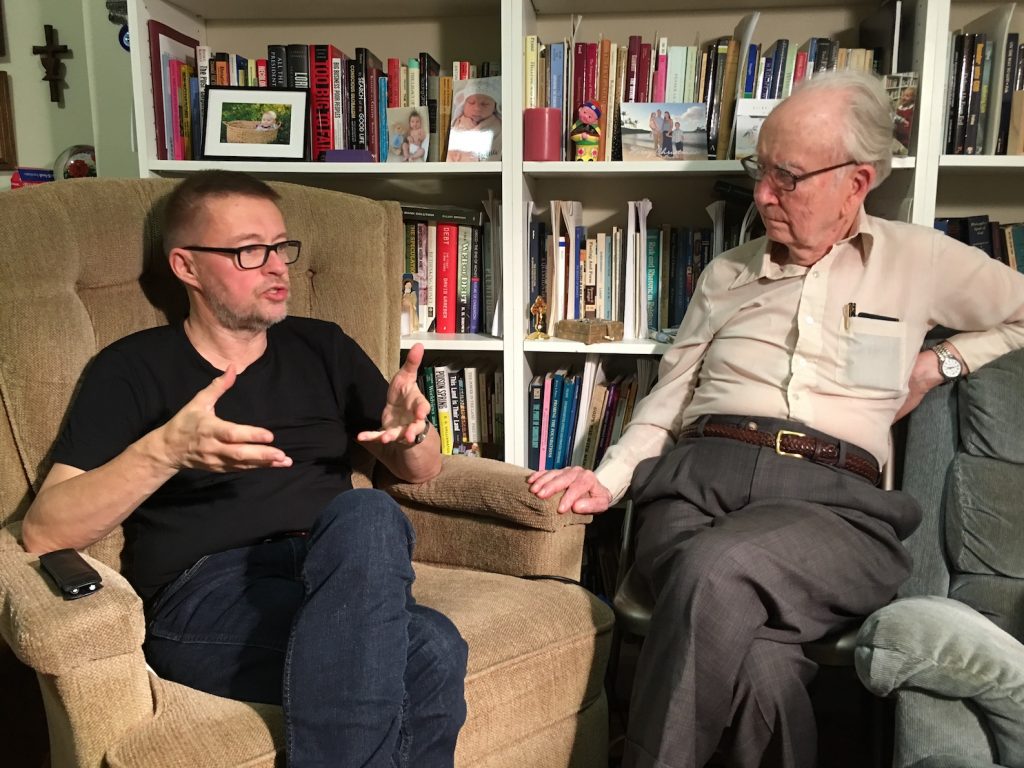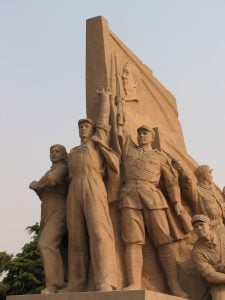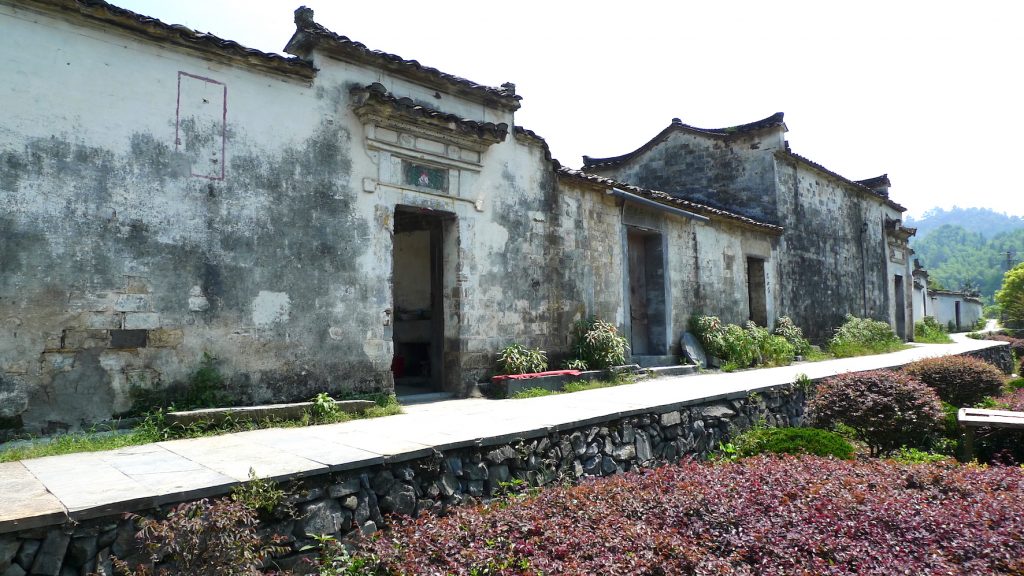In 1979 a popular uprising led by the Sandinista National Liberation Front (FSLN) overthrew the U.S.-backed Somoza-family dictatorship which had ruled Nicaragua since the 1930s, and in 1984 the Sandinistas and their presidential candidate, Daniel Ortega, decisively won the country’s first free elections in decades. The Sandinistas introduced a major programme of land redistribution and a significant expansion of public health care and education services. However, initial gains were undermined under the impact of an armed opposition (‘the contra’) organized and promoted by the U.S., a collapse of international raw material prices in the early 1980s, and Sandinista policy errors, including an over-ambitious programme of large-scale investments.
In 1990, a war weary population voted for a broad coalition led by Violetta Chamorro, the widow of a distinguished journalist murdered on Somoza’s orders. Chamorro’s government pursued a policy of national reconciliation but, in order to obtain much needed finance, was required to adopt exceptionally austere economic policies by the International Monetary Fund (IMF). Following a resumption of economic growth in the mid-1990s, elections in 1996 were won by a right-wing populist, Arnoldo Aleman, who was subsequently convicted to 10 years’ jail for corruption, and Aleman was followed in 2001 by his former vice-President, Enrique Bolaños, a fiercely anti-Sandinista business leader.
Following the Sandinista’s electoral defeat in 1990, many activists left the party as a result of dissatisfaction with Ortega’s leadership and the lack of internal party democracy. Some formed the small breakaway Movement for Sandinista Renovation (MRS), while others became involved in local development projects and in building an independent women’s movement. In 2006, however, the fractious liberal and conservative parties were unable to agree on a joint candidate for the presidential elections and this made it possible for Ortega, who had stood at every election since the 1980s, to win with a minority of the vote.
Despite a constitutional prohibition on consecutive terms in office, the electoral commission allowed Ortega to stand for the presidency again in 2011, and he was elected for a further term. The Sandinista dominated National Assembly subsequently agreed a constitutional change to allow consecutive terms, and in 2016 Ortega stood for the presidency yet again, this time with his wife, Rosario Murillo, as vice-presidential candidate. Shortly before the election, the main opposition candidates were disenfranchised, leaving Ortega and Murillo with a sure victory.
The Family-Party-State Nexus
Since resuming the presidency in 2007, Ortega has governed through a close alliance with Nicaragua’s principal business groups. COSEP, the main private business organization, had a highly conflictual relation with the Sandinista government in the 1980s but has enjoyed very close relations with the current government. The American Chamber of Commerce, which includes the major U.S. companies in the country, has also worked closely with the government, although after a heavily contested election in early 2018 the head of Cargill’s Nicaraguan subsidiary became president after campaigning for a more independent path. The government has also been able to count on the support of the leaders of the main unions, which are affiliated to the FSLN.
Ortega has tried to ensure that no political force emerges on the left and the breakaway MRS was unable to register for the elections in 2016. There are numerous right-wing parties, but they are small and in many cases little more than the personal fiefdoms of their leaders. Among the larger groups, the Partido Liberal Constitucionalista (PLC), which won the elections in 1996, has since the early 2000s provided political support for Ortega, initially under a ‘pact’ which allowed its leader, Aleman, to serve his jail sentence for corruption on his rural estate.
The other main right-wing grouping, the Partido Liberal Independiente (PLI), was the leading force in an electoral front which could have provided the most serious opposition to Ortega at the elections in 2016. However, this was effectively undermined a few months before the election when the country’s supreme court, which is dominated by Sandinista appointees, handed control of the party to a minority group. The party’s original candidates for the presidency and vice-presidency were prevented from running and its 28 representatives in the national assembly had to relinquish their seats. The PLI’s long-time leader – a banker – has since retired and former members of the party have established two new political organizations: Cuidadanos por la Libertad (CxL), which obtained legal recognition in May 2017, took part in the municipal elections later in the year; the Frente Amplio por la Democracia (FAD), by contrast, argues that current elections are a farce and it is concentrating on building a new movement from the base up.
At the general election in 2016, when the FSLN principal candidates, Daniel Ortega and Rosaria Murillo obtained 72% of the vote, the turnout was reportedly low as many people, including FSLN supporters, apparently considered the result to be a foregone conclusion. In the vote for the National Assembly, the FSLN obtained 70 out of 91 seats, with 14 seats going to Ortega’s tamed opposition, the PLC.
Ortega himself makes relatively few public appearances and there are unofficial reports that he is in poor health. Murillo, who was already playing an important role in coordinating the work of different government ministries, has come to play an increasing role in managing the day to day government of the country. Virtually all ministerial announcements are now made by Murillo, usually during a regular mid-day radio broadcast, and the mayors of the FSLN controlled municipalities are required to attend regular meetings with her in Managua. She has also build a strong base of support in the Sandinista youth movement, which has an important presence in the universities.
At the local elections in 2017, the FSLN won in 135 municipalities, while the PLC won in 11 and the new CxL in 6. However, as at the previous municipal elections in 2012, there were widespread allegations of irregularities and, in 2017, the extent of support for different parties was obscured because only figures for the share of the vote were published. In the most populated part of the country along the Pacific, the FSLN won strongly, but turnout was reportedly low; in central rural areas, where the contra had had a social base in the 1980s, the PLC and the CxL secured their best results; in the sparsely populated Caribbean area, there was also support for the local indigenous based party, but here the election was marred by violence between rival groups’ supporters. Reportedly, there was also discontent among long-time members of the FSLN at Rosario Murilla’s introduction of a centralized procedure for selecting candidates which, it was alleged, favoured her younger supporters.
The OAS and the USA
In response to the allegations of electoral irregularity, the secretary general of the Organization of American States (OAS), Luis Almagro, met with Ortega in February 2017. To the disappointment of Ortega’s critics, Almagro agreed to allow Ortega four years to rectify shortcomings in the country’s electoral system. Ortega is under strong international pressure to respond to the OAS but, having unexpectedly lost the elections in 1990, he appears intent on making the very minimum of concessions necessary to appease external critics so as to ensure that, at the elections due in 2021, either he or his designated successor will win.
Perhaps predictably the United States government and its ambassador in Nicaragua have been at the forefront of criticisms of Nicaragua’s onetime leftist president and his regime. The U.S. authorities have drawn attention to what they describe as ‘significant irregularities’ at the national and local elections in Nicaragua since 2011 and, in the aftermath of the national elections in 2016, members of the U.S. Congress from both main parties initiated the Nicaragua Investment Conditionality Act, which would require U.S. representatives at the World Bank and the Inter-American Development Bank to vote against approving any loans for Nicaragua. This was passed by the House of Representatives in October 2017 and requires Senate approval to become law. Meanwhile, the U.S. Agency for International Aid, which had been providing some $10-million a year in development assistance, included a mere $200,000 for Nicaragua in its budget for 2017/18, and nothing at all for subsequent years.
In a more pointed move, in December 2017 the U.S. deployed the Global Magnitsky Act to impose a ban on Robert Rivas, the president of Nicaragua’s electoral commission, from using banking services in the USA. Until then, the Act had only been used against Russian and Venezuelan government officials. Rivas had, inexplicably, accumulated numerous luxury properties in Nicaragua, Costa Rica and Paris. He has been a close ally of Ortega and, although his functions have since been officially transferred to his deputy, he has been allowed to retain his title as head of the electoral commission.
Nicaragua’s police and army were re-founded after the Revolution in 1979 and for long enjoyed an unusually high reputation for their probity. However, over the last ten years the number of complaints, particularly about the police, has been rising. Perhaps more seriously, there are also fears that the independence of the two institutions is being eroded. The police and the army both had established procedures whereby the top official would serve one term in office and then pass to retirement. In both institutions, however, the rules regarding retirement have been overridden, and subsequently changed by the National Assembly, and the current office-holders are serving their third consecutive terms. This, it is feared, has reduced their independence and gives at least an impression that they are beholden to Ortega.
The most important media in Nicaragua are television and radio, and these are largely in the hands of two groups which, between them, control 10 television channels. One group is owned by a Mexican businessman, Angel Gonzalez, whose channels are dominated by popular entertainment and avoid political controversy; the other group is controlled by the Ortega family, and transmits what has been described as a mixture of official propaganda, yellow journalism and mass entertainment. The one exception is channel 12, which is host to Nicaragua’s one critically informative current affairs programme.
Strong Economic Growth but Rising Inequality
Nicaragua, with a population of 6.2 million in 2017, has the second lowest per capita income in the Americas. Its economy has grown strongly in recent years, although output fell in 2009 as a result of the deep recession in the U.S. and other major markets. Between 2010 and 2017 economic growth averaged just under 5 per cent a year, the third highest in Latin America after Panama and the Dominican Republic.
The economy remains dependent on primary commodity exports, the most important of which are coffee, beef, gold and sugar. In addition, there has been a significant growth of production in export processing zones since the 1990s, primarily involving textile products and, more recently, the assembly of electrical harnesses for cars produced in Mexico. There is, however, still a large sector of subsistence farmers particularly in the more mountainous areas in the north of the country, and in the towns there is a very large commercial sector, much of it based on informal labour.
Nicaragua’s export revenues increased strongly up to 2014, although since then growth has slowed due to weaker world prices. In 2017 exports of goods amounted to $4.1-billion but imports at $6.6-billion were considerably larger. The deficit has been covered in part by family remittances which have increased considerably in recent years. Because of the employment situation in Nicaragua many families have at least one member who has gone abroad to work, principally to the United States or neighbouring Costa Rica, and in 2017 remittances amounted to $1.4-billion.
Nicaragua has also received substantial foreign direct investment in recent years, attracted by low wage levels and the relative security compared with neighbouring Honduras and El Salvador. Net direct investment amounted to $816-million in 2017, with the inflows directed principally to manufacturing industry, telecommunications, commerce and energy. The largest source in 2016 was Panama (22%), followed by the United States (13%) and Mexico (12%).
Until recently, Nicaragua benefitted from oil provided on very favourable terms by Venezuela. This was organized through a company called Alba de Nicaragua SA, or Albanisa, which is 51% owned by Venezuela’s state-owned oil company, and 49% by Nicaragua’s state-owned petrol company, Petronic. Under the terms of the deal agreed with Venezuela, Nicaragua was supposed to pay half the cost of the imported oil; the other half was effectively a long-term low-interest credit which provided Albanisa and a web of subsidiaries with funds to invest in a wide range of projects in Nicaragua. Between 2008 and 2014 Nicaragua is estimated to have benefited from some $3.5-billion in this way but, controversially, although a public debt, this major source of external finance was not registered in the government’s official figures.
As the economic situation in Venezuela deteriorated, the supply of oil declined and none was received in 2017. There were plans for Venezuela to build a major new refinery in the country but these have been abandoned. Nicaragua has since had to purchase oil on the international market and social expenditures financed with revenues from the Venezuelan oil have had to be reduced. At the same time, Nicaragua – strongly pressed by the International Monetary Fund – has begun to include the amounts owed to Venezuelan in the country’s official debt figures.
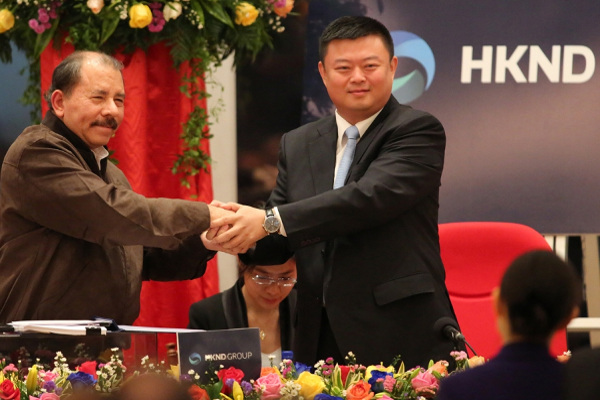
Nicaraguan President Daniel Ortega and Wang Jing of HKND Group.
In 2013, Nicaragua’s parliament granted a Chinese investor, Wang Jing, a 100-year concession to build and run an inter-oceanic canal through Nicaragua, a mega project that would be able to accommodate even larger ships than the Panama Canal, and which was viewed as a means of fast-tracking the country’s economic development. The $50-billion project was strongly opposed by environmentalists and also gave rise to a significant opposition movement among peasants whose land would have been compulsorily purchased and whose demonstrations were harshly restricted by the police. Work on the canal has been delayed amidst reports that Wang made large losses when the Chinese stock market crashed in 2015-16. From being a centre-piece of the government’s development plans, the canal was not even mentioned by Ortega in his address at the start of the new presidential term in 2017, and it seems unlikely that it will ever be built.
In recent years there has been considerable investment in communications and infrastructure. This is particularly notable in the condition of many roads. The main routes are being widened and resurfaced while the network of all-weather roads in rural areas is being steadily expanded. There has also been a notable expansion in access to electricity, especially in rural areas. According to official figures, coverage increased from around 70% of households in 2010 to 94% in 2017. The state-owned distribution company was privatized in 2000, but sold again in 2014 to a company which is registered in Spain, but which is widely believed to be linked to the government.
The supply of water has remained in the public sector and here too there has been investment in expanding its reach. But while some 90 per cent of households now have access to drinking water in urban areas, the figure is little more than 30 per cent in rural areas. There is a programme for building low income housing, but housing construction has been declining since 2015. According to the Association of Housebuilders, around half of the new homes built in 2017 were for low income households, but this amounted to a mere 2,500 units. There has, however, been investment in public spaces in many towns, providing play grounds together with seating and widely-used free access to the internet.
Sustained economic growth has led to a rise in the number of people in work. The official figure for the rate of unemployment fell to a low of 3.5% for men and 3.8% for women in 2017, but this presents a rather misleading picture, since workers without a formal job have little option but to seek an income from some type of informal employment. Even according to official figures, informal employment accounted for 42 per cent of the workforce in 2017.
The number of people who are formally employed and enrolled in the social security system has increased, from 534,881 in 2010 to 914,196 in 2017. This provides workers with a pension on retirement, but membership growth has slowed, and coverage is very uneven. While some 75 per cent of workers employed in the supply of electricity and water are insured, the figure is only around 45 per cent for workers in manufacturing industry and under 10 per cent in agriculture. The social security system is, in any case, seriously under-funded and, as the IMF has repeatedly warned, it will face a crunch which will place a further financial demand on the central government in 2019.
The employment situation has contributed to poor peasants in central regions of the country pressing toward the Caribbean in search of land to farm, a process exacerbated by the growth of large scale investments in capitalist agriculture, which have displaced many small farmers. This migration of ladino farmers has led to serious confrontations, some resulting in fatalities, with members of indigenous groups who, under the Nicaraguan constitution, are guaranteed exclusive rights to farm the land in Nicaragua’s autonomous Caribbean regions.
The limited employment opportunities in Nicaragua explain why so many workers seek work in other countries. Many of these migrant workers are unskilled, but skilled workers, including university graduates, have also been obliged to look for work abroad, and it is estimated that some 20 per cent of the population lives abroad. The remittances which they have sent back to their families have played a decisive role in maintaining living standards in the country.
On returning to office in 2007, the Ortega government launched an anti-poverty programme entitled Zero Hunger. This provided the poorest households with some basic agricultural support and, crucially, corrugated zinc sheets which enabled them to waterproof the roofs of their shacks. However, as the financial resources from Venezuela have declined, the Zero Hunger programme has been wound down, and subsidized electricity prices for low income households and for pensioners, which were also financed with Venezuelan resources, are to be phased out between 2018 and 2022. According to independent annual surveys carried out between 2009 and 2015, the proportion of the population living in poverty registered a limited decline, from 44.7 to 39.0 per cent, and those in extreme poverty from 9.7 to 7.6 per cent, with the most significant declines registered in rural areas.
After resuming the presidency in 2007, the Ortega government raised the official minimum wage significantly. However, for the great majority of workers, wage rises lagged behind inflation and it is only since 2010 that real wages have begun to register a rise. According to official figures, between 2010 and 2017 real wages for workers in formal employment increased by about 10 per cent when converted into dollars, or just over 1 per cent a year. By 2017, the average wage was equal to around $340 a month. In the financial sector and the mines, the figure was somewhat higher, at just over $500 a month, but in the manufacturing sector the average was equal to just $230, while the average for agricultural workers was a mere $130. For the government, low wage costs have clearly been an important part of their strategy for attracting foreign investment.
Nicaragua also has a prosperous commercial middle class and a very wealthy upper class. According to CEPAL figures, the top 10 per cent receives some 33 per cent of national income and, together with the next 10 per cent, almost 50 per cent of national income. This group includes traditional land-owning families, many of which have also branched out into commerce or industry; it also includes newly rich traders who have profited from the boom in commerce. According to the CEPAL report, while inequality declined slightly in the period from 2002 to 2008, as in virtually the whole of Latin America, Nicaragua was the only country where inequality increased between 2008 and 2014 (more recent figures are not available for Nicaragua). According to an Oxfam study published in 2015, there were 210 multi-millionaires in Nicaragua, each with net assets of over $30-million. Nicaragua’s wealthiest businessman, Carlos Pellas, is estimated to have accumulated a fortune of $2.4-billion, one of the largest in Central America, but some Sandinista leaders have also acquired wealth more recently, albeit on a lesser scale.
The Beginning of the End?
The Nicaraguan government faced a difficult economic outlook for 2018, with the threat a U.S. initiated limit on its access to international financial institutions, together with the need to adjust to the end of financial support from Venezuela. In the face of these challenges, growth projections for 2018 and 2019 have been reduced by both the IMF and the Nicaraguan central bank. In April 2018, Ortega was then confronted with the most serious political challenge to his rule since returning to office in 2007.
The government announced that, in order to address the Social Security System’s large deficit, pensions would be cut by 5 per cent and pension contributions would be increased for both workers and employers. A demonstration in Managua by pensioners against the reduction in their pensions was supported by students from the city’s public universities, but the student demonstrators were confronted by riot police and members of the Sandinista youth organization. Over the next three days the scale of the street confrontations increased, spreading to several other cities, and resulting in the death of over 40 people and many more injured.
After four days, Daniel Ortega appeared on television, flanked by his wife and the chiefs of the police and army, and he decried what he described as the manipulation of innocent students by political opponents with ulterior motives. But his failure to condemn the deaths led to yet further criticism, and in a second broadcast on the same day he announced the pension reforms would be cancelled and that the government would enter a dialogue with the country’s business organization on how to reform the pension system. The business organizations, which until then had enjoyed close relations with the government, said they would not enter negotiations until police violence against demonstrators was ended, and supported calls for a major peaceful demonstration the following day. It also insisted that any negotiations should include all sectors of Nicaraguan society.
On Monday, 23 April, tens of thousands joined a peaceful march in Managua and there were large demonstrations in many other cities. The authorities did not attempt to intervene and the demonstrations remained peaceful. The demands of the demonstrators had by now, however, gone beyond the issue of mere pension reform and broadened to include expressions of deep dissatisfaction with the Ortega family regime. In the absence of any serious political opposition, however, it was not clear what the alternative might be.
*
Trevor Evans teaches at the Institute for International Political Economy, Berlin School of Economics and Law.
Notes
1. Elecciones municipales 2017. Nicaraguas, tres escenarios diferentes, Envio, December 2017.
2. Observadores del eclipse institucional, Envio, September 2017.
3. Preocupa deterioro de relación con EE.UU., La Prensa, 23 March 2018.
4. See Centro Nicaraguense de Derechos Humanos (CENIDH), Informe Annual 2016, 2017.
5. The source for figures, if not otherwise given, is Banco Central de Nicaragua, Anuario Estadístico 2017, April 2018, available from www.bcn.gov.ni.
6. For details, see the series of articles on confidencial.com.ni by Iván Olivares, ‘La ‘alcancía’ de Albanisa’ (9 April 2016), ‘Una ‘pulpería’ de negocios’ (11 April 2016), and ‘La deuda: de Caruna a Albanisa’ (13 April 2016), and Enrique Saenz, ALBANISA, Confidential, 27 September 2017.
7. Fideg, Encuesta de hogares para medir la pobreza en Nicaragua. Informe de resultados 2015.
8. CEPAL, Panorama Social de América Latina, 2017.
9. Oxfam, Desigualdad Extrema y Secuestro de la Democracia en América Latina y el Caribe, 2015.
All images in this article are from the author.



